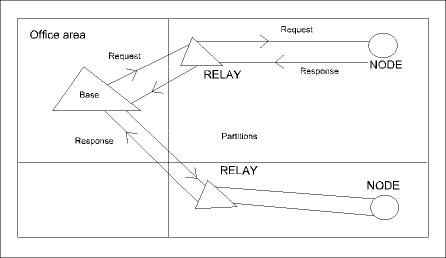
This article describes a temperature measurement system consisting of battery- powered wireless nodes with BetaTherm NTC thermistors. It is a practical solution for applications requiring continuous access to temperature readings in areas where it is impractical to using conventional cabling.
The nodes can be simply placed in a random set of different locations and once switched on, will await passively in a low power sleep mode for a command from a remote central host station. The host can interrogate every node which will fully wake up and perform a temperature measurement for transmission in a short burst to the central host. The central host can also ask each node for a status report to ensure that any problems can be reported and fixed.
Generic module
The WRS100 consists of a pre-programmed microcontroller, antenna and radio transceiver included on a single FR4 substrate. The necessary networking software for the microcontroller has already been written and implemented in several applications. The module consumes 38 mA during transmission and 8 mA during reception. Between these conditions the module consumes 50 mA. The low amounts of data allow for managing the duty cycle of transmission and reception in order to cut current consumption.
Thermistor
The thermistor chosen is the 10K3A1. BetaTherm has a list of its R-T characteristics. The device has a nominal resistance of 10 kΩ at 25°C. Figure 1 shows two resistors RS and R1 in series with the thermistor. RS is used to limit the power dissipation while R1 linearises the output of the thermistor. The output voltage across R1 varies from 33 mV at -50°C to +2,329 V at +100°C. The thermistor requires a constant voltage source and hence additional circuitry (DC-DC converter) is needed on the output of the battery cell. The same stable voltage is fed into the module as a stable reference (2,5 V) for the internal 10-bit A/D converter.

An electrochem lithium thionyl chloride battery is used which is rated at 3,67 V and 5000 mAh. The radio will run at 4800 bps and a message will be 12 bytes in length. This means a transmission time of 20 ms is necessary for every message. Hence, in order to achieve a battery life of two years the average rate of transmission cannot exceed one message every minute continuously.
The base station is a WRS100 module with an RS232 serial interface. Using the two I/O pins on the module a half duplex RS232 type interface can be formed with the PC using a standard DB9 connector. An additional PCB could be used to hold the module and the connector and provide an interconnect between the two.
A PC running HyperTerminal, LabView or HPVEE set to N-8-1 parameters is used to control the base station interrogating it for A/D data and displaying the data on screen. A look-up table with relevant R-T values and ADC-count to resistance look-up table is used to calculate the temperature. Naturally, every slave would have a unique ID so it is possible to associate the relevant temperature readings.
Definition of network components and functions
The network is made up of three elements (base station, node, relay). Each element consists of a WRS100 module. The base station has a DB9 serial connector for providing an RS232 type interface to the PC. The relay is physically exactly the same as a slave but without a Thermistor attached. The layout of these elements is shown in Figure 2.

The following are the guidelines adhered to by each element in the network:
* A transaction consists of a base station radio message 'request' followed by a slave or relay radio message 'response'.
* Every transaction is always initiated by the base station.
* A transaction response from a specific slave or relay is always expected if the request message included a specific (non-zero) remote module ID.
* The retransmission of a radio message request or response by a relay node is regarded as 'echoing' or 'relaying' the REQ/RSP.
* slaves and relays ignore the receipt of any radio message they receive in error.
* A request message frame with a target device ID of zero is regarded as a 'broadcast poll' and destined to all remote slaves and relays.
The PC always begins initiation of an RS232 message sequence while the base station remains in an idle state (the mark state) until it is activated by the RS232 message. It will not respond to any invalid, unrecognisable request sent by the PC.
The maximum speed using the WRS100 is 4800 bps. Although the serial communications operate at 9600 bps, the radio link is slower due to extra sampling in order to overcome errors in data recovery.
Each device has a range of 100 m LOS (line of sight). Inside a building this will typically go down to between 30 and 40 m depending on environment. In order to ensure coverage relay devices are located in areas of weak coverage which extend the range. The radio transceiver chip operates in an unlicensed band at 433,92 MHz with a maximum power of 10 mW. The module is designed to satisfy the European EMC regulation EN300 220.

Conclusions
Measuring temperature using a BetaTherm thermistor together with a Bourns WRS100 system is a good solution for projects requiring remote monitoring with no cabling. All radio network and serial protocols are embedded into the module which streamlines the system design for the customer allowing him or her to focus on the task of the application itself.

© Technews Publishing (Pty) Ltd | All Rights Reserved